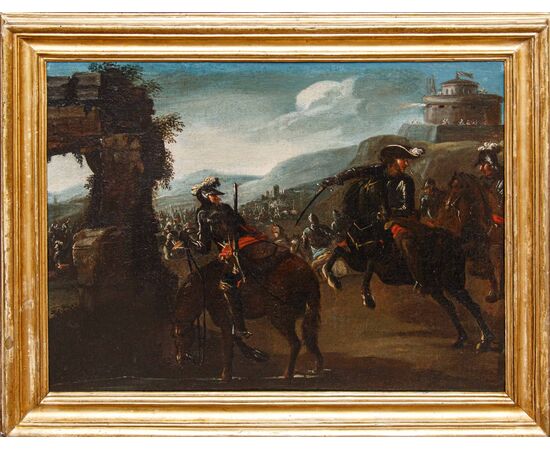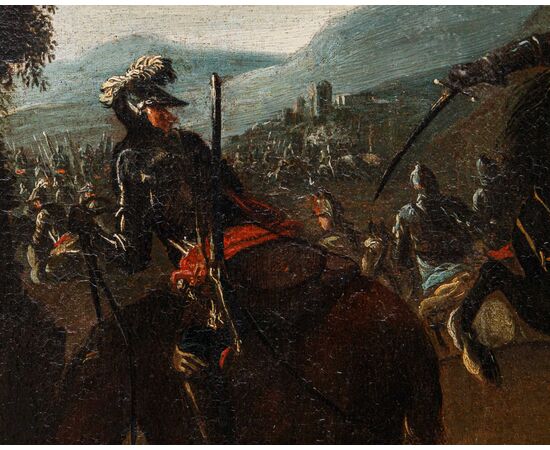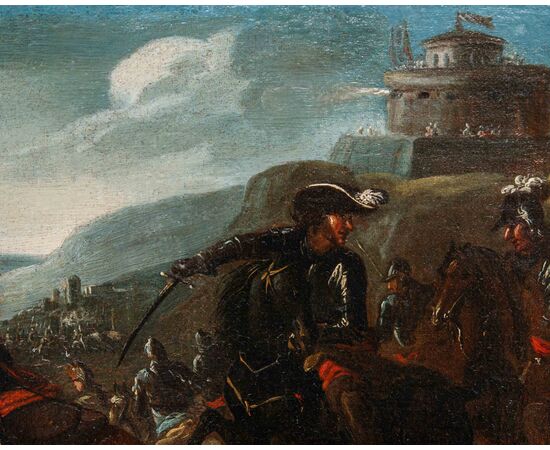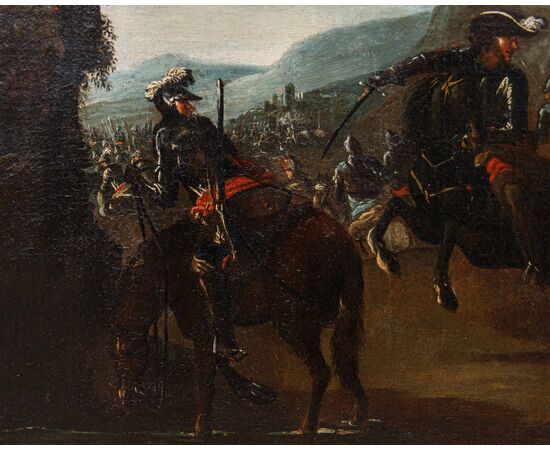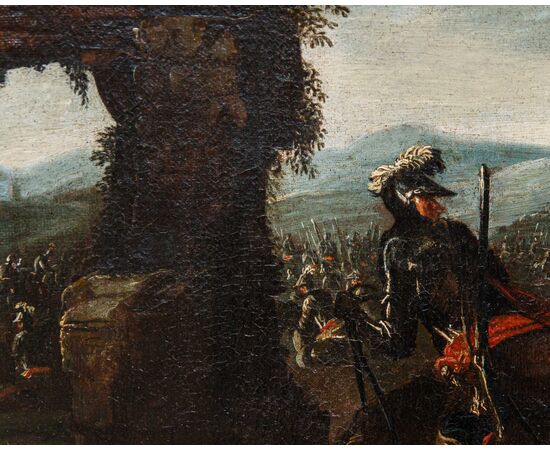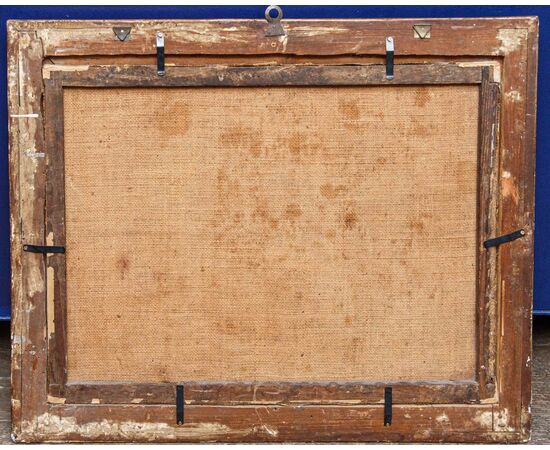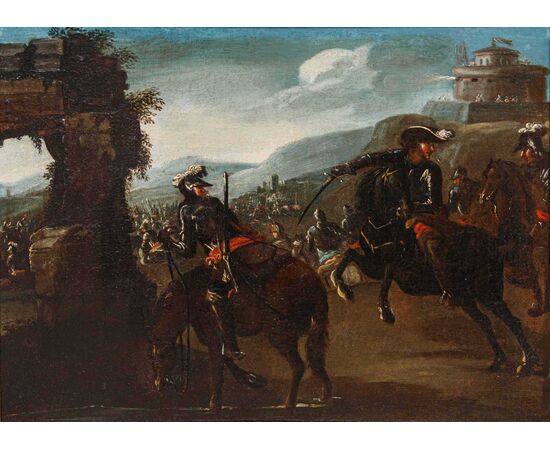The Siege of Montalcino, Girolamo Cenatiempo (documented between 1705 and 1742)
Girolamo Cenatiempo (documented between 1705 and 1742)
The Siege of Montalcino during the War of Siena
Oil on canvas, 49 x 64 cm
With frame, 61 x 74 cm
The battle scene shown here depicts the episode of the siege of the fortress of Montalcino, at that time belonging to the Republic of Siena, as can be seen from the black and white flag hoisted on the fortress in the background on the right of the painting, the final phase of the famous War of Siena (1554 - 1555). In the painting, we find the Spanish Florentine soldiers distinguished by the red band, led by Cosimo I de Medici, who will be the victors of the clash, accompanied by the defeated French, commanded by the Marshal of France Piero Strozzi, here intent on fleeing. The War will end on April 17, 1555 with the final capture of the fortress by the former, which will see Siena forced to surrender and given to the Medici of Florence.
The canvas belongs to the production of Girolamo Cenatiempo, a painter about whom little biographical information is available but of whom it is possible to partially reconstruct the corpus of works, thanks to the studies of Giancarlo Sestieri, who over the years has identified several works attributable to his hand, linking them to those already recognized as signed and dated. Information about his life is documented from 1705, the year in which he is registered with the confraternity of Saints Anne and Luke. The first works mentioned are those created for the church of San Pietro a Maiella in Naples, both paintings and frescoes, while in 1709 he is found in Abruzzo, in L'Aquila, where he creates the Sermon of San Bernardino with Saints Giovanni da Capestrano and Giacomo della Marca for the vault of the mausoleum of San Bernardino in the homonymous basilica. Also dating back to his stay in L'Aquila are a San Benedetto and a Santa Scolastica, now in the collection of the National Museum of Abruzzo, as well as the paintings made for the chapel of the Holy Family and that of Sant'Ignazio in the church of Santa Margherita. Two years later he returns to Naples, where he works for the churches of Santa Maria della Sapienza and that of Gesù Vecchio, where he painted numerous canvases for the various chapels, before returning again to L'Aquila for a commission from the Jesuit Order. He continued to shuttle between L'Aquila and Naples in the following years, leaving constant traces in the places of worship in the cities and the surrounding area: in 1722 in Naples, in the church of San Pietro Martire, he worked with his brother Ignazio, also a painter, on a cycle of Episodes from the Life of Saint Antoninus, Bishop of Florence for the church of San Pietro Martire, then he will work for the basilica of San Bernardino in L'Aquila, and create the Madonna in Glory and Saints Maximus and George for the apse of the cathedral of Saints Maximus and George. There are still numerous commissions received in the following years, often in collaboration with other artists within the ecclesiastical construction sites, although many have been modified or damaged over time; the Crucifixion of Saint Andrew from the Cathedral of Fidenza and now in the National Gallery of Parma is certainly worth mentioning. The critical event concerning the rediscovery of Girolamo as a battle painter began with Federico Zeri, in whose photographic library are preserved the images of two 'Ancient Battles' (oil on canvas, 100X178 cm), formerly in the San Giorgi antique gallery in Rome, where on the back one reads: 'Hieronimus Cenatiempo f. 1718. Student of Solimena'. It is thanks to these photos that Sestieri in 1999 gave shape to a first cataloging aimed at 'identifying a specialist who had gone unnoticed'. Gerolamo Cenatiempo, a student of Solimena and active in Naples in the first half of the eighteenth century, was known for his paintings mentioned above, while his production in the field of battle went unnoticed until the modern age. See as terms of stylistic comparison some unpublished paintings depicting war scenes and sieges of fortifications, which allow a broader reconstruction of the battle line of his pictorial corpus, tending to approach the works of Ciccio Graziani, of which it reproposes entangled cavalry clashes enlarged in a larger format. The spatial opening in the background, the fortress of Montalcino on the top of the hill on the right and the ruins are elements that are found in the settings of the other war scenes represented by Cenatiempo, who perfectly restores the excitement and frenzy of the battle also through the superimposed, sudden and contorted movements of the soldiers and their cavalries, as in the case of the two knights in the foreground. The opacity of the tones of the background is contrasted by the vivid colors and light reflections that make up the figures emerging from the background, made with a more evident three-dimensionality thanks to a more full-bodied and consistent drafting, composed of rapid touches that outline the shapes of the body with dynamism and volume.
With Ars Antiqua it is possible to spread all amounts up to a maximum of € 7,500 at ZERO RATE, for a total of 15 INSTALLMENTS.
Ex. Tot. € 4,500 = Monthly installment € 300 for 15 months.
Ex. Tot. € 3,600 = Monthly installment € 720 for 5 months.
For amounts exceeding € 7,500 or for a longer spread over time (over 15 installments), we can provide a customized payment.
Contact us directly for the best quote.
LIVE TV
– SUNDAY 17.00 – 21.00 Dig.terr. 126 - Sky 824
– Streaming on our website www.arsantiquasrl.com and on our social media Facebook and Youtube
All the works offered by Ars Antiqua are sold with a certificate of authenticity according to law and accurate in-depth information.
You can see the works directly at the Milan showroom gallery, in via Pisacane 55 and 57.
We personally organize transport and delivery of the works, both for Italy and abroad.

